These alkaline dumplings (碱水粽子, Jian Shui Zong Zi) are extra tender and gooey, filled with red bean paste and has a heavenly earthy fragrance. I included detailed step-by-step photos and a video to help you make the perfect zongzi to celebrate the Dragon Boat Festival! {Gluten-Free, Vegan}
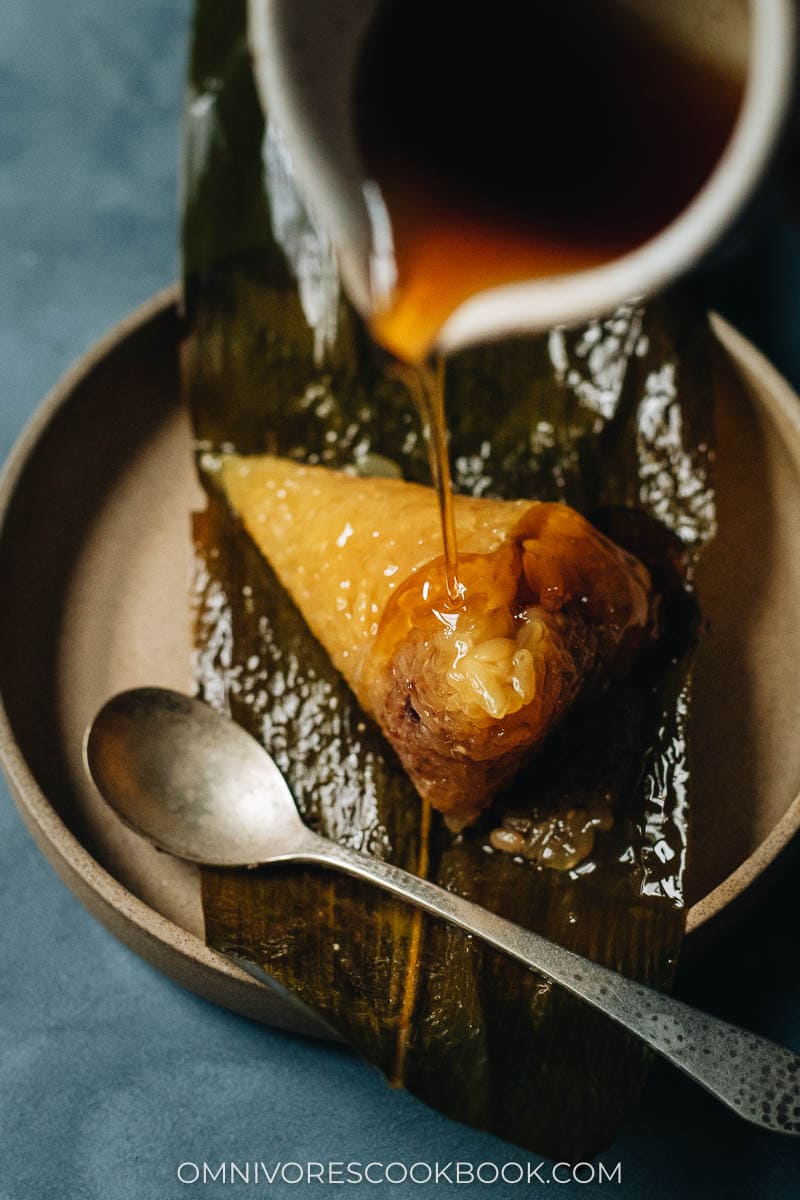
Are you making zongzi for this year’s Dragon Boat Festival? If you’re looking for a new recipe to try out, you might want to make these lovely alkaline dumplings. Compared to your average sweet zongzi, alkaline zongzi have a more tender and gooey texture with a lovely yellow color that is so pretty. I know it’s quite a lot of work to make zongzi, but the freshly made zongzi are so fragrant and nothing beats the smiles on your friends and family members’ faces when you share the fruits of your labor of love.
What is Alkaline dumpling
Alkaline dumplings, or Jian Shui Zong Zi in Mandarin, are also called alkaline zongzi, lye water zongzi, and Gan Sui Jong (Cantonese). It’s a classic dish from the southern part of China, such as the Shanghai and Guangdong regions. It’s a festive dish to serve during Dragon Boat Festival (端午节), but it’s also quite often seen at dim sum restaurants or served as a dessert.
Growing up in Beijing, we usually only make the regular sweet zongzi. I wasn’t very familiar with Alkaline dumpling until moving to the US where I got exposed more to Cantonese culture. Not to mention, I was immediately hooked on these delicious dumplings and now I cannot get enough of them.
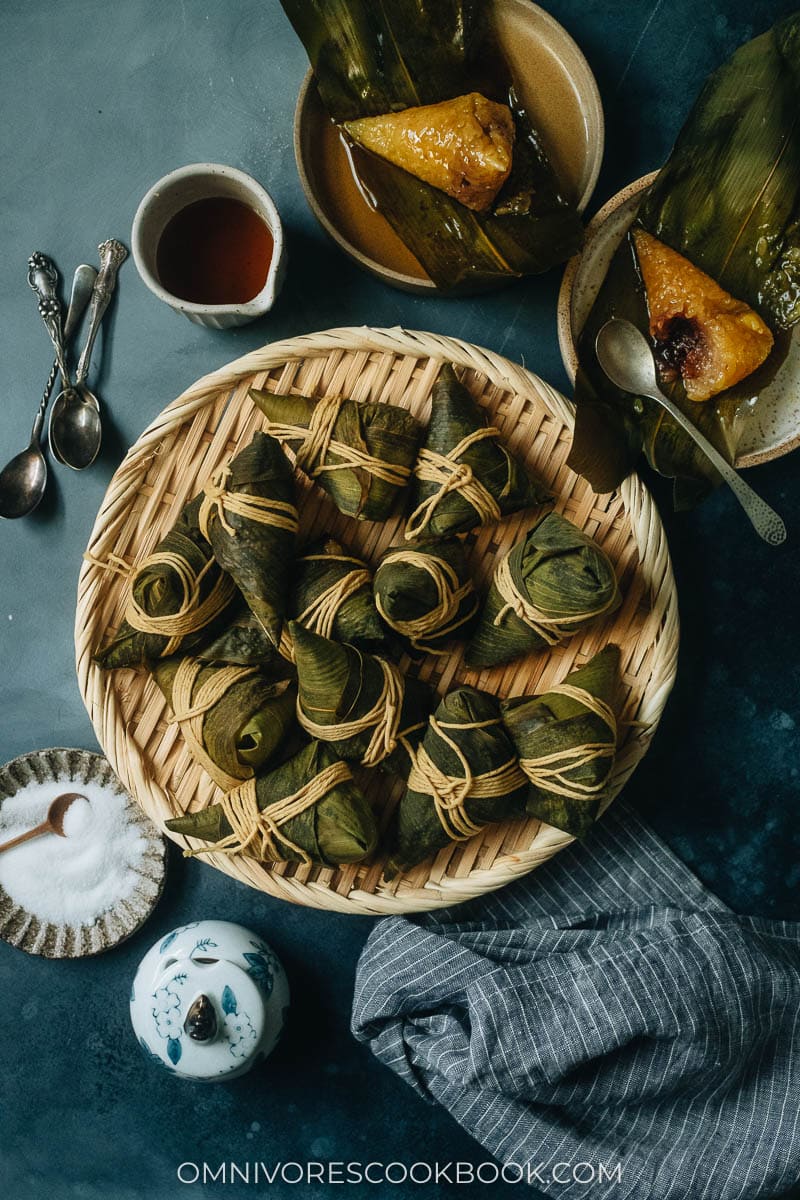
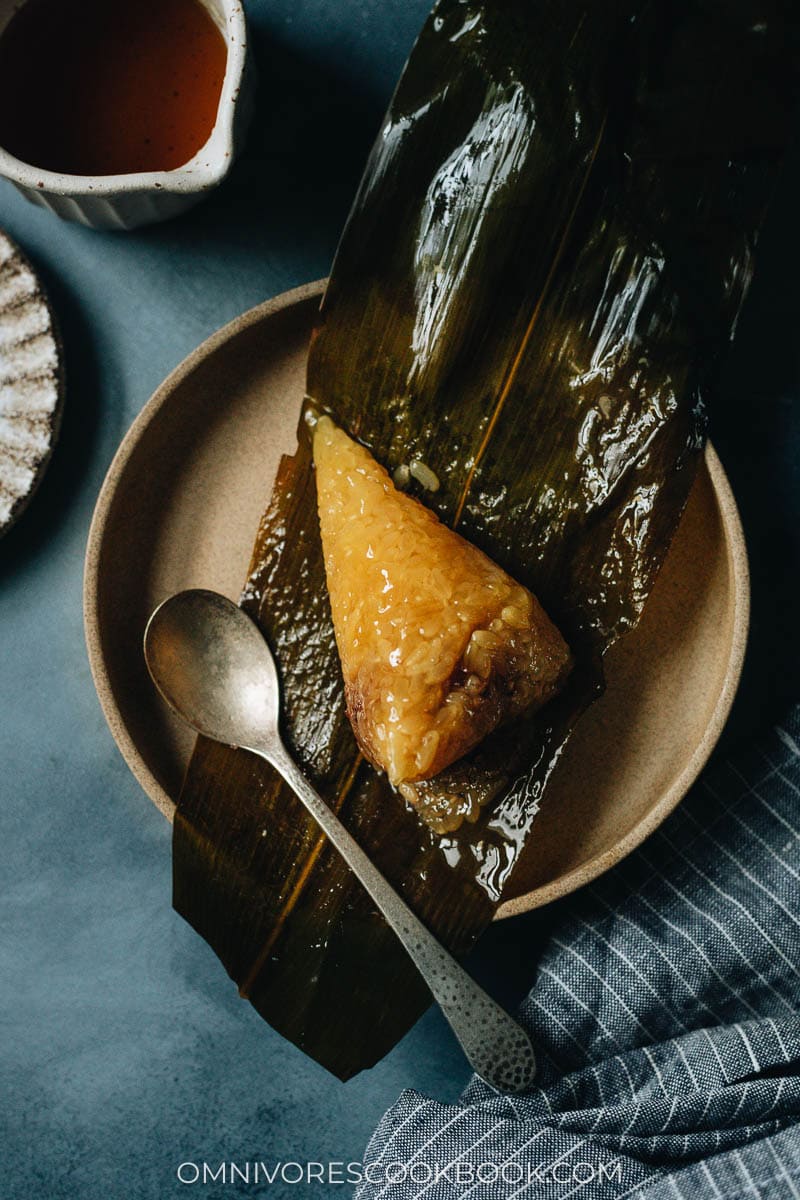
What’s special about alkaline dumplings
Alkaline dumplings are made with sticky rice that’s pre-soaked in alkaline water. The alkalinity does a few things to the zongzi:
- It makes the sticky rice extra tender and gooey, creating a better mouthfeel.
- The alkaline water will dye the zongzi to a beautiful yellow color, creating a more appealing look.
- Alkali is a natural preservative so the zongzi can be stored a bit longer.
When using an alkaline solution, you need to be careful about the quantity. If using too much, the zongzi will end up with a sulfuric taste or even taste bitter.
Ingredients for making alkaline dumplings
Alkaline solution (lye water)
Food grade alkaline solution is the key ingredient in alkaline dumplings. It can be acquired in different forms. In China, you can easily find food-grade alkaline powder. Some very traditional recipes call for the natural ingredient Chao Mu Hui (草木灰), which is the ash from burned plant matter. But the most commonly seen ingredient is alkaline solution, which is a solution of potassium carbonate and sodium bicarbonate. If you’re familiar with Cantonese style mooncakes, the kansui used in that recipe is the alkaline solution you’re looking for.
It’s possible to make an alkaline solution at home. But in this recipe I used store-bought lye water. These days you can find lye water on Amazon. Also, if you can find zongzi (bamboo) leaves in an Asian market, chances are, they probably carry lye water as well.
I’ve also seen quite a lot of Chinese recipes that use baking soda to make alkaline dumplings. But since I haven’t tested the result, I’m not including it as an alternative in the recipe below.
Sticky rice
You will need short grain sticky rice (糯米), which is also called glutinous rice or sweet rice. Although it has “glutinous” in the name, the rice itself is gluten-free.
You can easily find sticky rice at Asian markets or even on Amazon. Make sure to select the short grain type for the most authentic texture.
Bamboo leaves
You will need bamboo leaves to wrap the alkaline dumplings. The bamboo leaves will impart on the rice a fragrance that is grassy and earthy, giving them a heavenly aroma. Fresh bamboo leaves are ideal. If you live near a big Asian or Chinese market, you might be able to find them in the freezer section. If fresh ones are not available, the dried ones will totally work. Many Chinese markets carry them and some Asian markets will carry them during the month leading up to the Dragon Boat Festival (May-June). These days you can even find them on Amazon.
Red bean paste (Optional)
Traditional alkaline dumplings are often served plain, and you can dip them in the syrup or sugar. But red bean paste filling is quite popular and it makes the zongzi quite tasty. That’s why I included it in the recipe as an option. You can make red bean paste at home using this recipe. You can also easily find it at many Asian markets or even on Amazon.
Besides those ingredients, you will also need some kitchen twine to tie the zongzi.
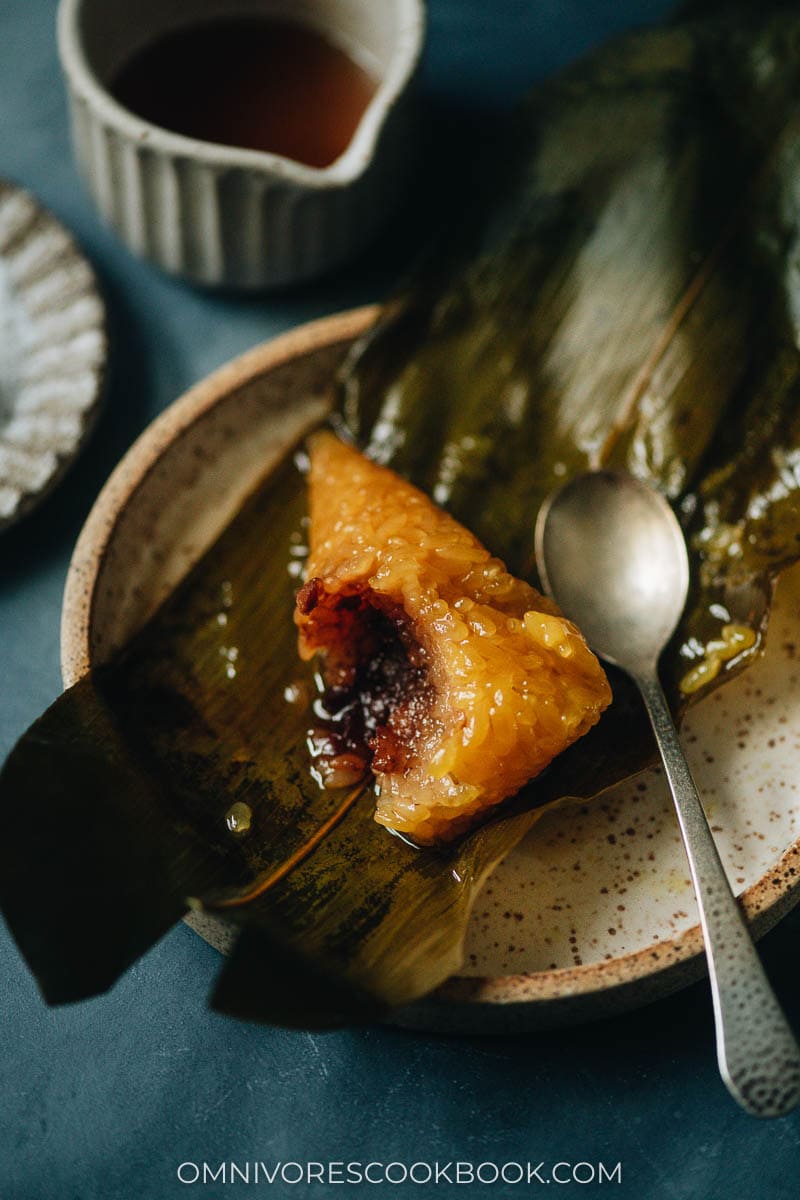

Prepare ahead
Making zongzi requires a bit of time and patience.
The night before
You will need to be organized and do a few things the night before wrapping the zongzi.
- Soak the bamboo leaves in water to rehydrate them, so they will be pliable
- Soak the sticky rice in water with alkaline solution and some oil
To soak the bamboo leaves, you will need to find a very big bucket or basin to fully submerge them. If using a bucket, rinse the leaves with water and gently bend them so they can be placed against the side of the bucket. If you don’t have either, you can use your kitchen sink.
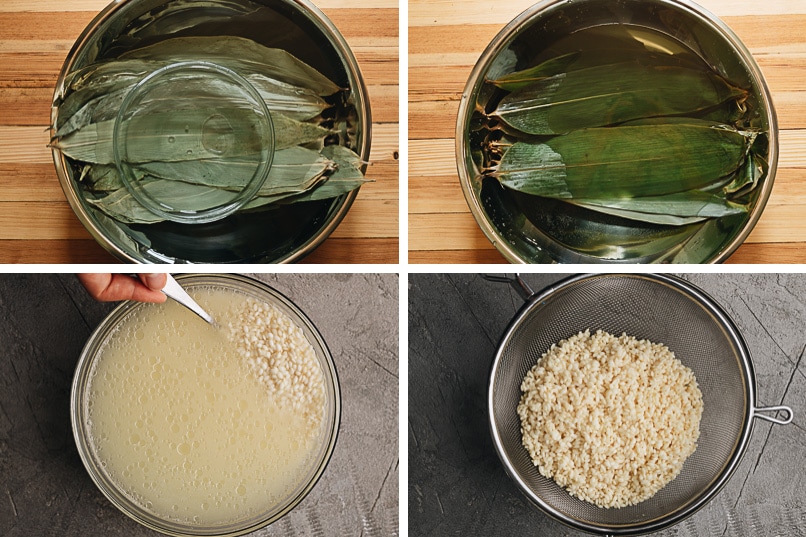
How to wrap alkaline dumpling (zongzi)
It took me quite a while to practice and make good-looking zongzi. The process can be a bit tricky if you’ve never made them before. That’s why I included a lot of pictures below, and made a video for it. Just so you can see how it’s done. Also, just remember that there are many ways to wrap zongzi and you can choose any of the methods.
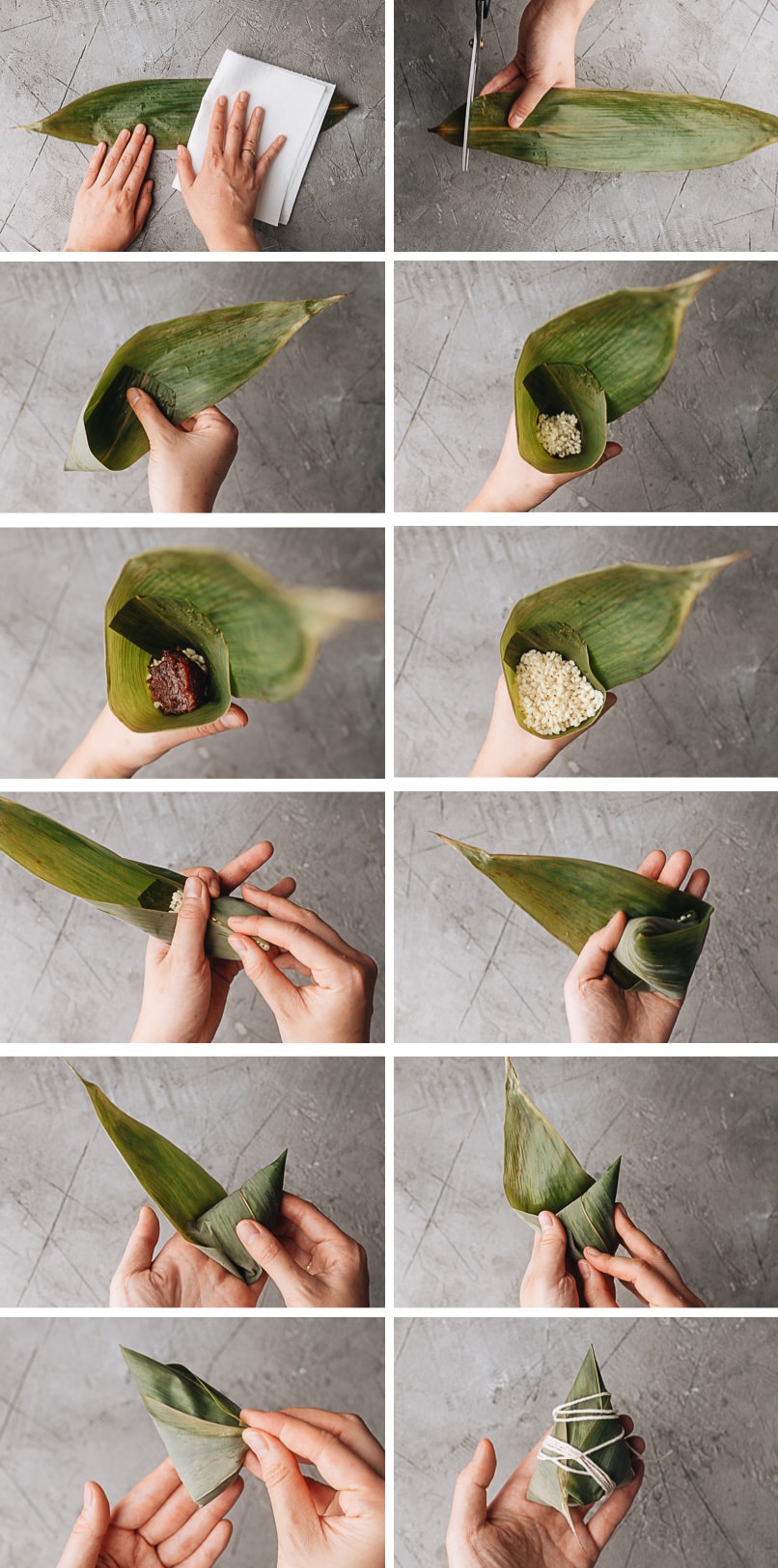
The wrapping method here uses only one piece of bamboo leaf to make small zongzi. I like to use this method to make alkaline dumplings because it’s the perfect dessert size. If you prefer bigger zongzi, you can use the method from this post.
How to cook alkaline dumplings
You can cook alkaline dumplings on the stovetop or in an Instant Pot (or pressure cooker). I personally prefer the Instant Pot method because it’s much faster and you can set it up and forget about it. If cooking on the stove top, you will need about 3 hours and you should check on the zongzi during that time. In an Instant Pot, the zongzi take about 1 hour of cooking time. Although you will need to leave about 40 minutes to 1 hour on top of it, to add and release the pressure.
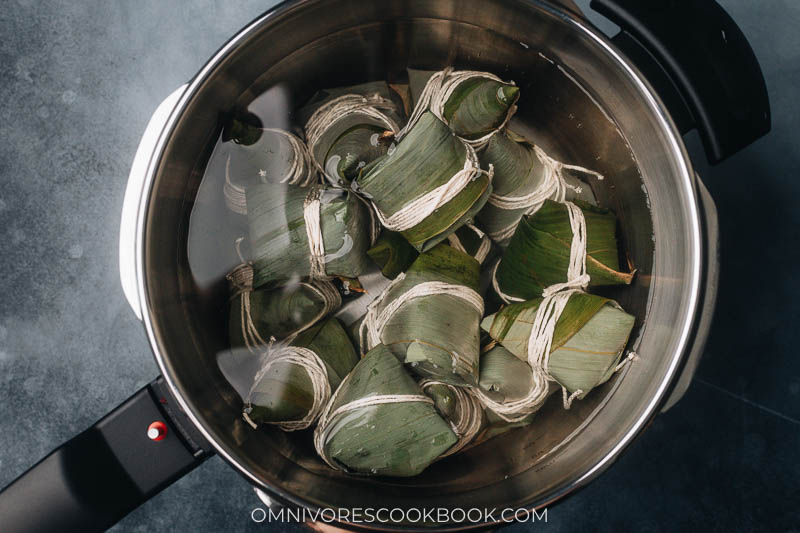
How to serve alkaline dumplings
Plain alkaline dumplings are usually served with white sugar or syrup. I like to use maple syrup, but you can use other types of syrup as well. If you happen to find osthamus syrup at a Chinese market, definitely give it a try because it has such a lovely fragrance.
If you use sweet bean paste as the dumpling filling, you might not need other sweeteners. But I do like to pour a ton of syrup on my sweet bean paste zongzi 🙂

How to store and reheat alkaline dumplings
Alkaline dumplings can be refrigerated or frozen once cooked. The refrigerated ones will stay good for about 1 week and the frozen ones up to 3 months. To properly reheat them, steaming or boiling works best. For refrigerated ones, the microwave works pretty well.
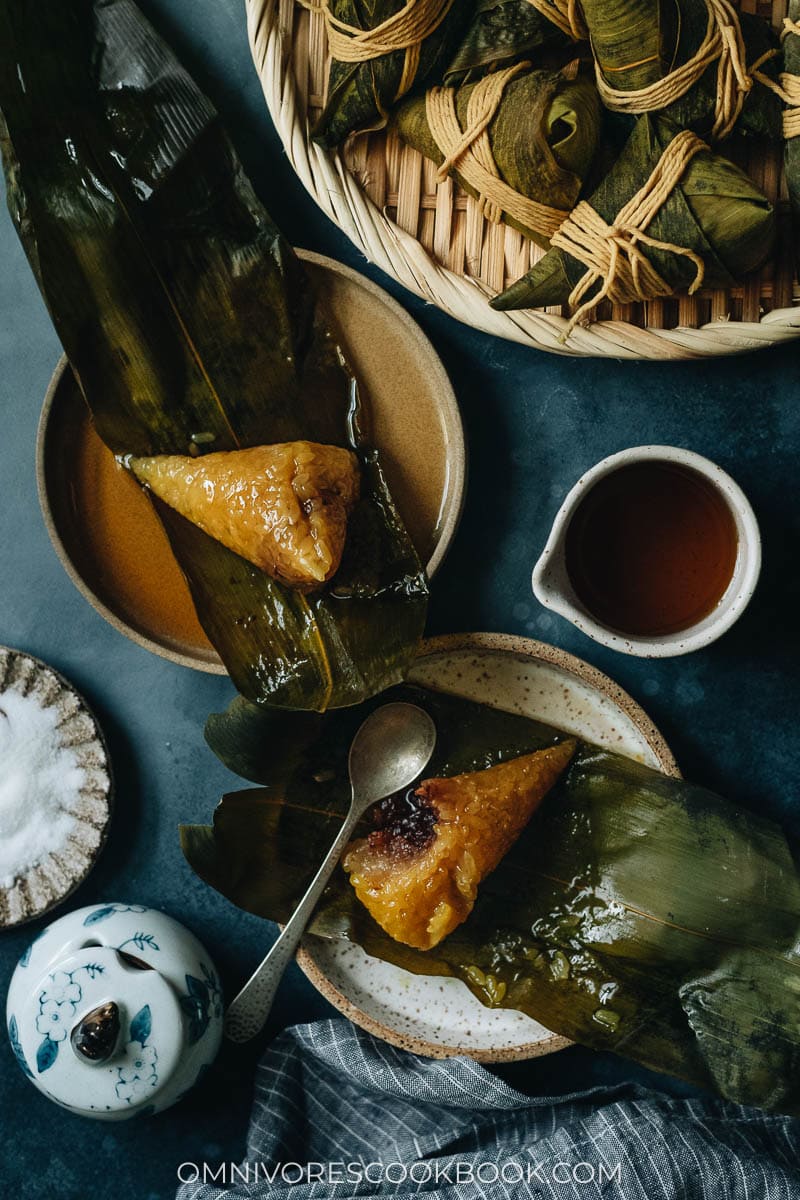
Afterthoughts
Making any type of zongzi is definitely a special event that requires time and patience. Back when I was living in China, it was usually a family event and the process was so much easier when working as a team. In the US, it takes me way longer to prepare and wrap zongzi. But I love to share them with my friends and it always makes me so happy when I get tons of positive feedback. I hope you enjoy these alkaline dumplings and happy dragon boat festival!
More Dragon Boat Festival Recipes
- Pork Zongzi (Cantonese Savory Sticky Rice Dumplings)
- Zongzi with Red Bean Paste (Sticky Rice Dumplings)
- How to Make Red Bean Paste
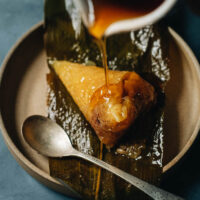
Alkaline Dumplings (碱水粽子, Jian Shui Zong Zi)
Ingredients
The Night Before – Soak the Rice and Bamboo Leaves
- 2 cups (1 lb / 450 g) short grain sticky rice (glutinous rice)
- 1 tablespoon alkaline water (or homemade kansui)
- 1 tablespoon vegetable oil
- 20 to 30 bamboo leaves , dried or fresh, dried requires soaking (*Footnote 1)
The Next Day – Make and Cook Zongzi
- 1 cup red bean paste homemade or store-bought (Optional) (*Footnote 2)
- 1 teaspoons alkaline water (or homemade kansui)
- Kitchen twine
Serving
- Maple syrup (or white sugar)
Instructions
The Night Before – Soak the Rice and Bamboo Leaves
- Add the sticky rice to a big bowl and water to cover 1” (2 cm) above the rice. Add the lye water and vegetable oil. Stir to mix well. The water will turn pale yellow due to the lye water. Cover the bowl and let soak in the fridge overnight, or for at least 8 hours.
- In a large tray or bucket, add the dried bamboo leaves and water to cover. Weigh the leaves down with a big bowl filled with water or something heavy so all the leaves are submerged. If the tips of the leaves do not submerge, splash them with water and leave as-is.
The Next Day – Making and Cooking the Zongzi
- Drain the water from the sticky rice. Rinse the rice a few times with running tap water. Use your hands to rub the rice a few times to remove any residual lye water. Drain again and set aside.
- Drain the leaves and wipe each of them down on both sides with a paper towel.
To wrap the Zongzi (see the step-by-step pictures above, or watch the video)
- Take one bamboo leaf, making sure it does not have any holes or tears. Use a pair of kitchen scissors to cut off 1” (2.5 cm) from the tough end (the base of the leaf). Face the smooth sides towards yourself. This is the side that will contain the filling. A third of the way along the leaf, wrap the tough end over the longer side and fold it into a cone shape, with the leaf sticking out from one end.
- Hold the cone using one hand and begin to add the filling with your other hand. Add about 1 tablespoon of the sticky rice to the bottom and press it lightly with your finger. Add about 1 tablespoon of red bean paste. Keep adding the sticky rice while gently pressing and smoothing the rice, until it almost fills up to the low side of the bamboo leaf, leaving a 1/4” (1/2 cm) lip.
- Take both of the short open sides of the zongzi between your thumb and index finger and fold the sides inwards, covering the rice. Fold the long leaves over the open area, tightening between your thumb and index finger to create a pointed triangular shape. Then flip the zongzi over and wrap the leaves around tightly to seal it. Tie the zongzi with a piece of twine, making sure it is cinching any area where the leaf might come loose, and tie it off in a way that will keep the leaves together, but not too tight that it squeezes the rice out (The rice will expand during cooking, and you want to leave space for it). For extra security, you can use another piece of twine to wrap the zongzi again, this time crosswise.
Cook the zongzi
- Cook on the stovetop: In a large pot, arrange the zongzi neatly to fill up the bottom of the pot with minimal gaps in between. Keep the zongzi as snug as possible so they do not move around a lot during cooking. Fill the pot with water, cover about 1” (2.5 cm) above the top of the zongzi. Add 1 teaspoon of lye water to the pot, stir to mix well. Bring the water to a boil, and then turn the heat to medium-low or low, and cover. Simmer the zongzi for 3 hours. Check the water levels periodically, replenishing the pot with boiling water when the waterline falls below the top of the zongzi.
- Cook in an Instant Pot or pressure cooker: Arrange the zongzi in an Instant Pot or pressure cooker and water to cover. Keep all the zongzi in one layer with minimal gaps in between if possible. Close the lid and make sure the valve is sealed. For the Instant Pot, choose “Manual” at “High Pressure” and set a timer for 50 minutes. For a pressure cooker, heat over medium heat until pressure is added, then turn to low heat and cook for 50 minutes. Once done, let the Instant Pot release the pressure naturally
- Drain the zongzi from the water. Serve hot, warm, or at room temperature with sugar, maple syrup, or any other type of sweetener/syrup you prefer.
Store or reheat
- Once the zongzi have completely cooled off, store them in sealed containers or ziplock bags. Store them in the refrigerator for up to a week, or in the freezer for 3 months. To reheat the refrigerated ones, you can microwave, steam, or boil them. To reheat the frozen ones, boiling or steaming works much better. For the refrigerated ones, steam or boil for 10 minutes. For the frozen ones, steam or boil for 25 minutes.
Notes
- This recipe makes 16 small zongzi. If you use two pieces of bamboo leaf (like the bigger zongzi from this recipe), you will make about 10 zongzi. I always prefer to soak a bit more bamboo leaves than needed, just so I can pick out the best ones as I wrap.
- Traditional alkaline zongzi usually do not contain any filling. But red bean paste is a great choice to add texture and flavor, if it’s something you prefer.













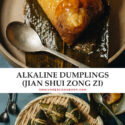
I would love to try this recipe, do you think that bamboo leaves can be reused after use?
Usually the bamboo leaves are not reused. I think you could, but it takes a lot of work to clean them (the sticky rice will leave residual on them), and you’ll need to make sure they are quite intact after all the wrapping and unwrapping. The other thing is, the bamboo leaves will infuse a nice flavor to the rice. I imagine that if you use them, they will be less fragrant because you’ve boiled them for a long time.
If you can find bamboo leaves, they are actually quite affordable and it comes with a giant stack (I usually have a ton of leftover leaves). So I wouldn’t worry too much about reuse them.
Hi, I have tried the recipes, it taste great but have some problems with some uncooked rice, what is wrong?
If the center of the dumplings have uncooked rice, it’s probably because you needed to boil them more. Due to the size of the dumplings and how tight you wrap them, the cooking time will change. If you wrap the dumplings very tight, it’s also difficult to cook through. Did you cook it on stovetop or an Instant Pot?
can you add red beans to the rice in addition to the red bean paste. If so, do I need to soak the beans with the rice in lye water.
If you prefer a texture with the red beans, the best way is to make the bean paste from scratch, so buy the cooked and seasoned red beans (you can easily find the canned type in Japanese market) and add to the paste.
We do sometimes add the red beans to the sticky rice so the finished up zongzi will have bites of beans in them. In this case, you need to soak the beans in clear water separately overnight.
But I’m not sure if it will produce a good texture if you add the beans in the paste.
You can make red bean paste using this recipe: http://omnivorescookbook.com/recipes/how-to-make-red-bean-paste (before mash the beans, scoop some out and save for later)